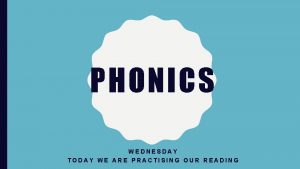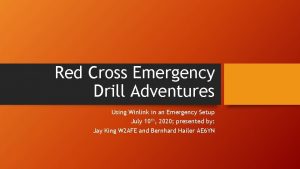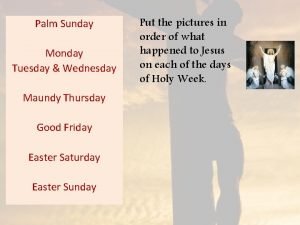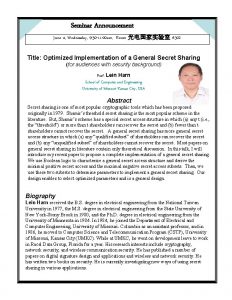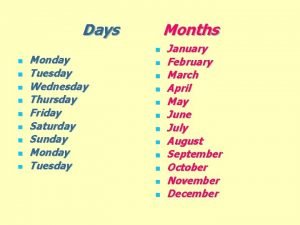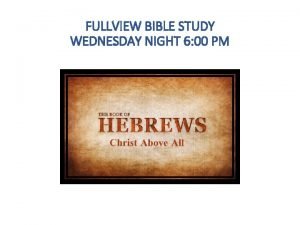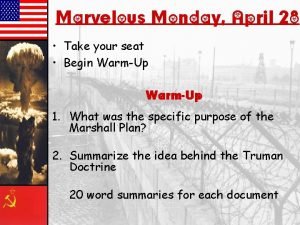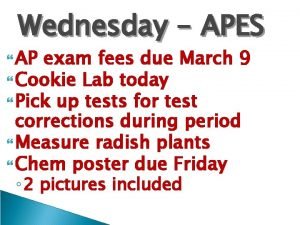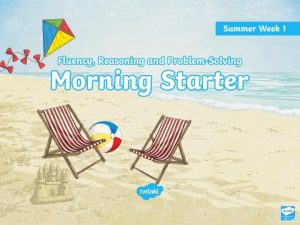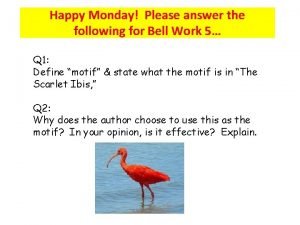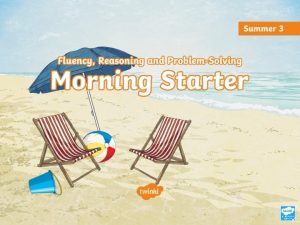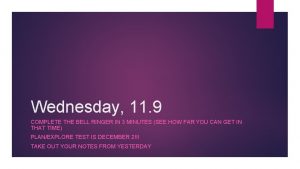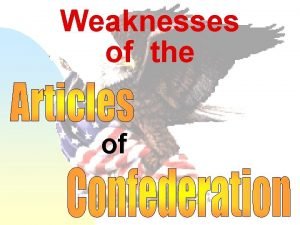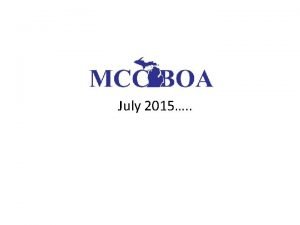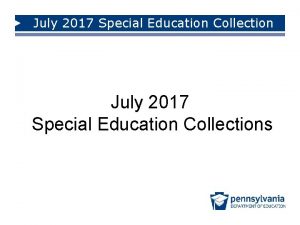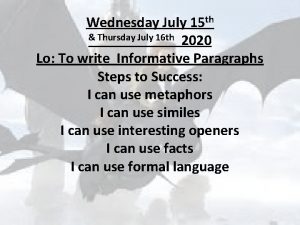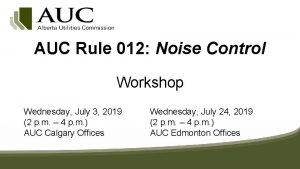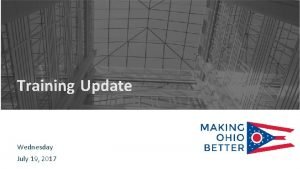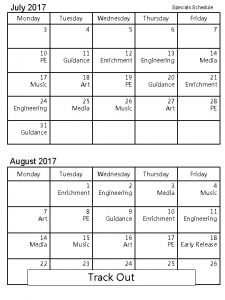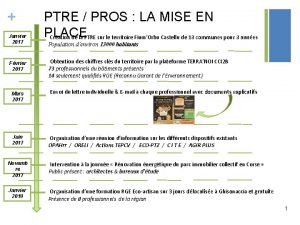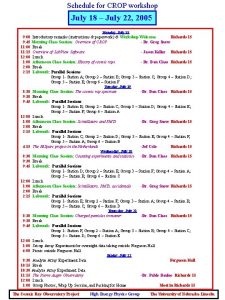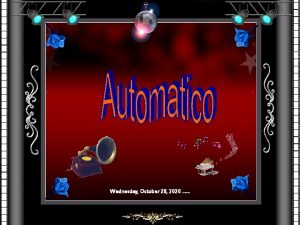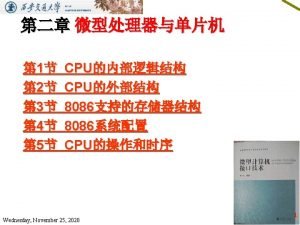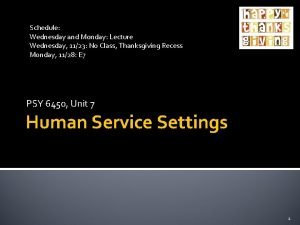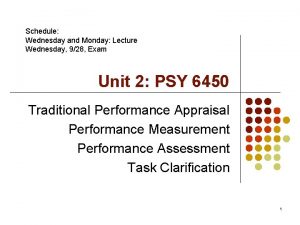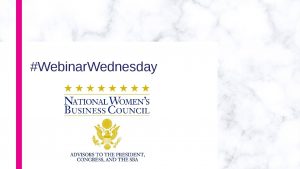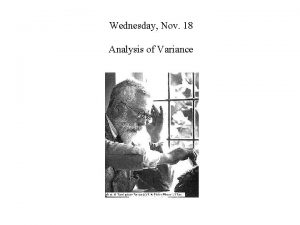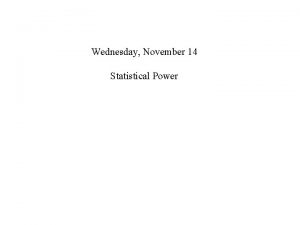STPMM Workshop Wednesday July 26 2017 9 30










































- Slides: 42

STP-MM Workshop Wednesday, July 26, 2017 9: 30 a. m. - 11: 30 a. m. 1: 30 p. m. – 3: 30 p. m.

What is an MPO? A regional, multi-modal transportation planning agency created by federal law to: • • • provide a forum for project selection by local officials set policy and guide the transportation planning process develop a multi-modal, 25 -year Metropolitan Transportation Plan (MTP) • develop a multi-modal, four year Transportation Improvement Program (TIP) 2

Alamo Area MPO Region 5

Alamo Area MPO Transportation Policy Board Member Representing Commissioner Kevin Wolff, MPO Chair Bexar County Councilman Rey Saldaña, MPO Vice-Chair City of San Antonio, District 4 Rebecca Cedillo, Board Member Advanced Transportation District Vacant Alamo Regional Mobility Authority Commissioner Tommy Calvert, Jr. Bexar County Commissioner Sergio Rodriguez Bexar County Renee Green, P. E. , County Engineer Bexar County Commissioner Kevin Webb Comal County Councilman Ron Cisneros Kendall County Geographic Area Councilman Ron Reaves City of New Braunfels Councilwoman Shirley Gonzales City of San Antonio, District 5 Councilman Greg Brockhouse City of San Antonio, District 6 Councilwoman Ana Sandoval City of San Antonio, District 7 Bridgett White, Planning Director City of San Antonio Mike Frisbie, P. E. TCI Director City of San Antonio Mayor Don Keil City of Seguin Mayor Chris Riley, Leon Valley Greater Bexar County Council of Cities Judge Kyle Kutscher Guadalupe County Mayor Pro Tem Kevin Hadas, Selma Northeast Partnership Mario Jorge, P. E. , District Engineer Tx. DOT San Antonio Dr. Richard Gambitta, Board Member VIA Metropolitan Transit 4

AAMPO Committees Transportation Policy Board Executive Committee 9 members Meet as Needed 21 voting members Meet on the 4 th Monday Technical Advisory Committee (TAC) 19 members Meet on the 1 st Friday Bicycle Mobility Advisory Committee (BMAC) 22 members Meet on the 2 nd Wednesday Land Use & Regional Thoroughfare Subcommittee Freight, Rail & Transit Subcommittee Pedestrian Mobility Advisory Committee (PMAC) 17 members Meet on the 3 rd Wednesday Traffic Incident Management Subcommittee Public Information Officers Meet on the 1 st Wednesday 5

Required MPO Plans and Documents Unified Planning Work Program (UPWP): Budget and Planning Studies over a two year timeframe (adopted June 2017) Metropolitan Transportation Plan (MTP): Future goals, strategies and transportation projects for 25 years (adopted December 2014) Transportation Improvement Program (TIP): Funded transportation projects within 4 years (adopted in April 2016, new TIP will be adopted in April 2018) 6

Transportation Improvement Program (TIP) • Covers a time period of four years • Formally updated every two years • Financially constrained • Developed cooperatively among the partner agencies • Must be consistent with the Metropolitan Transportation Plan • Approval process occurs in two steps with presentation one month and action the next month • Approved TIP is tentatively due to Tx. DOT in May 2018 7

Types of Projects in the TIP • • Additional vehicle lanes Alamo Area Commute Solutions Program Bicycle and pedestrian facilities Bus and van purchases Major planning studies Operational/Safety improvements Transit passenger facilities 8

State and Federal Funding Categories in the TIP • Category 1 – Preventive Maintenance and Rehabilitation • Category 2 – Metropolitan Area Corridor • Category 3 – Non-traditional funding sources (local contribution) • Category 4 – Connectivity • Category 7 – Surface Transportation Program Metropolitan Mobility (STP-MM) • Category 9 – Transportation Alternatives Program • Category 11 – District Discretionary • Category 12 – Strategic Priority • Transit project funding 9

STP-MM: Project Funding History • 2011 Call for Projects (FY 2013 -2016 TIP) – 73 projects totaling nearly $1 B were submitted – 19 projects were selected for funding at an amount of nearly $92 M • 2013 Call for Projects (FY 2015 -2018 TIP) – 56 projects totaling nearly $435 M were submitted – 19 projects were selected for funding at an amount of nearly $110 M • 2015 Call for Projects (FY 2017 -2020 TIP) – 40 projects totaling nearly $400 M were submitted – 23 projects were selected for funding at an amount of nearly $166 M (programmed funding out two years past the TIP) 10

STP-MM: Overview and Requirements • “MPO Funded Projects” • Approximately $127, 000 is available to program • Roadway projects must be on “functionally classified roadways”, not local streets • Required minimum 20% cash match for the project construction cost • Written commitment of project development costs and local match required from the implementing agency • Reimbursable program; not a grant program and all state and federal rules apply 11

STP-MM: Overview and Requirements • Rehabilitation and maintenance projects are not eligible for funding consideration • Projects must be in areas open to the public • Projects submitted for funding consideration must have a minimum construction cost of $1, 000 • For infrastructure projects: only eligible items related to construction will be reimbursable; project development costs are the responsibility of the implementing agency • Implementing agencies will be required to sign the project understanding form 12

STP-MM: Overview and Requirements • The application package must contain a detailed cost estimate • If an agency submits more than one project, the MPO requires the agency to prioritize projects • Cost overruns are the responsibility of the implementing agency; or re-scope project with Transportation Policy Board approval • Although the Transportation Policy Board makes all funding decisions associated with STP-MM funds, Tx. DOT is the federal designated pass-through agency for this funding source. Entities awarded funding will enter into agreements with Tx. DOT will require reimbursement of their costs for review and coordination of the project. 13

STP-MM: Overview and Requirements • Selected projects will be placed in years based on readiness and financial constraint – TIP: fiscal year 2019, 2020, 2021 or 2022 – MTP: fiscal year 2023 or 2024 and moved into the TIP as funding becomes available 14

STP-MM: Eligible Project Categories • Added Capacity – roadway projects which add through travel lanes. These projects would also include bicycle and pedestrian facilities. • Operational – projects which improve the operational function of a facility without adding through lanes. Examples include: – – – – – Improving intersections, including adding right or left turn lanes Adding a center turn lane Adding acceleration or deceleration lanes Constructing a roundabout Adding or improving intersection signalization Constructing new or reversing ramps Converting frontage roads from two way to one way Reconfiguring travel lanes for a multimodal shift Implementing ITS projects Constructing an interchange 15

STP-MM: Eligible Project Categories • Stand Alone Bicycle – projects which construct, reconstruct, or upgrade public bicycle facilities. • Stand Alone Pedestrian – projects which construct, reconstruct, or upgrade public pedestrian facilities. • Other – Projects which do not fit within the other major categories. Past examples include: – Public Transit Projects – Major Planning Studies Projects that are solely Maintenance or Rehabilitation are not eligible 16

STP-MM: Project Scoring Overview • Added capacity, operational, stand alone bicycle and stand alone pedestrian projects will be technically scored • Other projects including transit, rideshare or planning studies will not be scored • 1, 000 point scoring system • Additional points for providing additional local contribution (overmatching) to the construction cost of a project 17

Project Scoring: Added Capacity Projects – 40% Congestion (using existing or base year volume/capacity ratio, projected 2040 volume/capacity ratio and if the project is on the region’s Congestion Management System) – 20% Cost of the project per 2040 vehicle miles of travel – 10% Considers safety – 10% Supports the MPO’s adopted long range plan growth scenario – 10% Project includes safe pedestrian facilities – 10% Project includes safe bicycle facilities + 50 points for providing additional local contribution of 5% to 10% beyond the required 20% local match towards the construction cost of a project + 100 points for providing additional local contribution of more than 10% beyond the required 20% local match towards the construction cost of a project 18

Project Scoring: Operational Improvement Projects – – – 45% 15% 25% 10% 5% Operational/Multimodal improvement Cost of the project per 2040 vehicle miles of travel Considers safety Supports the adopted long range plan growth scenario Supports safe bicycle and pedestrian facilities + 50 points for providing additional local contribution of 5% to 10% beyond the required 20% local match towards the construction cost of a project + 100 points for providing additional local contribution of more than 10% beyond the required 20% local match towards the construction cost of a project 19

Project Scoring: Stand Alone Bicycle Projects – 40% Considers safety – 60% Improves accessibility and mobility + 50 points for providing additional local contribution of 5% to 10% beyond the required 20% local match towards the construction cost of a project + 100 points for providing additional local contribution of more than 10% beyond the required 20% local match towards the construction cost of a project 20

Project Scoring: Stand Alone Pedestrian Projects Considers safety Serves high demand pedestrian generators Completes a sidewalk gap Project is supported by a Walkable Community Workshop, existing adopted plan, or uses strategies outlined in the Pedestrian Safety Action Plan – 10% Incorporates pedestrian design enhancements – – 30% 20% 10% + 50 points for providing additional local contribution of 5% to 10% beyond the required 20% local match towards the construction cost of a project + 100 points for providing additional local contribution of more than 10% beyond the required 20% local match towards the construction cost of a project 21

Project Scoring: Other • “Other” projects (rideshare, planning studies, transit projects) are not technically scored • If a multi-use path is submitted it is scored as both a stand alone bicycle project and a stand alone pedestrian project and the higher score is used throughout the process 22


STP-MM Call for Projects and TIP Development Schedule • March 27, 2017: Announce Call for Projects • April - May 2017: MPO Committee presentations • May 22, 2017: Transportation Policy Board adoption of TIP development process • June 1, 2017: Call for projects begins • July 26, 2017 – Two workshops, similar in content and format, will be held to provide information and support to submitting agencies • June – November 2017: Agency project development and secure local match • December 4, 2017: Project submittals are due to the MPO 24

STP-MM Call for Projects and TIP Development Schedule • January 2018: Projects are scored by MPO Committees • February 2018: MPO hosts public meetings/workshops • March 2018: Technical Advisory Committee and Transportation Policy Board review the draft TIP; action will be taken on the STP-MM project funding list • April 2018: Technical Advisory Committee and Transportation Policy Board take action on the TIP • May 1, 2018: Approved TIP is due to Tx. DOT (tentative) 25

26

Project Submittal Form: Excel Spreadsheet • • One page submittals of this form only Do not exceed the space provided for each response Complete yellow shaded portions only Do not revise formulas 27

Submitting agency: must be an agency that Tx. DOT is able to enter into an agreement with (City, County, VIA) Contact person name, e-mail and phone number: provide contact information for person that can answer questions about the project Project/Roadway name: usually a roadway name: “Blanco Road”, “Commerce Street” Limits from/Limits to: also usually roadway names Description of work: “Expand from 2 to 4 lane roadway with center turn lane”; “Construct sidewalks on both sides of roadway”; “Construct multi use path”; there is a 120 character limit 28

Project length: enter the mileage into the yellow shaded portion Federal functional classification: roadway projects must be on functionally classified roadways; a map is available on the AAMPO website through the i. Map application Eligible project category: project must either be an “Added Capacity”, “Operational”, “Bicycle”, “Pedestrian”, “Rideshare”, “Transit”, or “Other” project type as defined earlier Project justification: why is this project important: respond only in the space provided; as examples cite multimodalism, system connectivity, improves accessibility, has high crash rates, high growth area, or high density area 29

Functionally Classified Roadways in the Alamo Area MPO Region 30

These are calculated fields; do not enter numbers here Agency overall priority: if an agency is submitting more than one project identify which project is #1 priority, #2 priority and so forth. If an agency is submitting only one project that is its #1 priority. Agency category priority: if an agency is submitting more than one added capacity project, as an example, then in addition to identifying the overall priority, the projects must be prioritized within that category. Project construction/activity cost minus additional contribution: enter the total construction cost only. This cost does not include preliminary engineering, right-of-way, or other project development costs. Additional local contribution: enter the additional local contribution amount. This amount is over and above the required 20% local match. In most cases this will be ‘ 0’ as most agencies do not overmatch projects. 31

Local match source: identify the source of the local match funding for the project: bond program or sales tax revenue, as examples. Other Federal funds cannot be used as match for this program. Add’l local contribution source: identify the source of the additional local contribution for the project. Bicycle component costs: for construction projects, estimate the portion of the construction cost that is for the bicycle portion of the project. Pedestrian component costs: for construction projects, estimate the portion of the construction cost that is for the pedestrian portion of the project. What adopted plans and/or policies does this project help to implement? Identify the adopted plans, policies and programs that this project supports. 32

Does the implementing agency have an adopted ADA Transition Plan? (for information purposes only): respond ‘Yes’ (and provide the date of adoption) or ‘No’. Neither response will help nor hinder a project from being funded. Has the implementing agency previously successfully completed an MPO project: respond ‘Yes’ or ‘No’. Known environmental issues: in the project in an environmentally sensitive area? Is the project over the Edwards Aquifer recharge zone? What is the status of the environmental document preparation? Known drainage and utility issues and requirements: is the project in a flood plain? Are drainage structures included in the project?

Land Use Maps 34

Typical Cross Sections 35

Detailed Cost Estimates Detailed cost estimates need to be made for each project to minimize cost overruns down the road. If the construction cost estimate increases as a selected project is developed, and exceeds the amount programmed in the TIP, the submitting agency must cover the cost increase or rescope the project to reduce the cost with MPO Transportation Policy Board approval. 36

Project Commitment Form The Project Commitment Form needs to be signed by an upper level individual within the submitting agency.

Commitment of Local Match (and overmatch if applicable) 38

39 ck Cli re he

http: //www. alamoareampo. org/yourmove/ 40

www. alamoareampo. org www. sagisday. com 41

Questions? Thank you! Jeanne Geiger Deputy Director geiger@alamoareampo. org 210 -227 -8651
 Wednesday
Wednesday Skinny wednesday
Skinny wednesday Wednesday phonics
Wednesday phonics Happy wednesday
Happy wednesday Wednesday evening prayer
Wednesday evening prayer Wednesday bellwork
Wednesday bellwork Happy wednesday march
Happy wednesday march Wednesday lo
Wednesday lo Wednesday syllables
Wednesday syllables Wednesday diary
Wednesday diary Wednesday bellringer
Wednesday bellringer Thursday prayer
Thursday prayer Winlink wednesday
Winlink wednesday Tuesday-sunday
Tuesday-sunday Wednesday good morning
Wednesday good morning Wednesday seminar
Wednesday seminar Monday tuesday wednesday thursday friday saturday sunday
Monday tuesday wednesday thursday friday saturday sunday Wednesday at 6
Wednesday at 6 Borwick hall outdoor education centre
Borwick hall outdoor education centre Happy wednesday february
Happy wednesday february Marvelous monday terrific tuesday wonderful wednesday
Marvelous monday terrific tuesday wonderful wednesday Fe exam results wednesday
Fe exam results wednesday Tuesday thursday friday saturday
Tuesday thursday friday saturday Monday=621 tuesday=732 wednesday=933
Monday=621 tuesday=732 wednesday=933 Thursday prayer images
Thursday prayer images History ia mark bands
History ia mark bands Wednesday journal prompts
Wednesday journal prompts English class is wednesday
English class is wednesday Function of lipids
Function of lipids My favorite day is saturday
My favorite day is saturday Response to happy monday
Response to happy monday Monday tuesday wednesday thursday friday calendar
Monday tuesday wednesday thursday friday calendar Enum week sunday monday
Enum week sunday monday Wise wednesday
Wise wednesday Monday=621 tuesday=732 wednesday=933
Monday=621 tuesday=732 wednesday=933 Wednesday bell ringer
Wednesday bell ringer Web analytics wednesday
Web analytics wednesday Wednesday bellwork
Wednesday bellwork 2003 july 17
2003 july 17 May 1775
May 1775 July 26 1953
July 26 1953 June too soon july stand by
June too soon july stand by July 12 1776
July 12 1776


